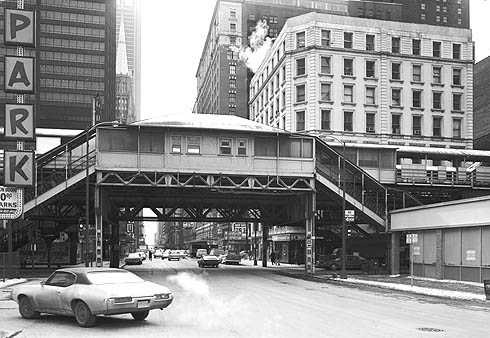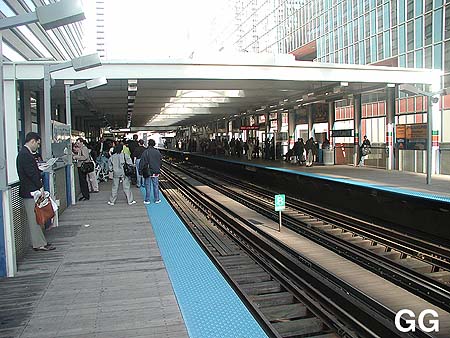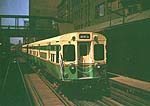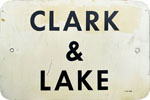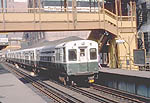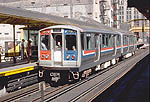|
History:
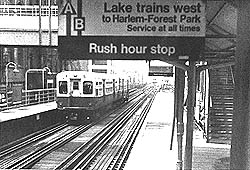
Clark/Lake in the
1970s, with a second version 6000-series
"L" train on the inner track. For a larger view,
click here.
(Photo from
Destination Loop)
|
Clark/Lake, like State/Lake
to the east, was constructed before the rest of the Loop
because the tracks, while originally part of the Lake Street
line, were always meant to be the north leg of a downtown
loop, connecting at Wabash.
All four legs of the Loop employed a different, unique
style for its station houses and the Lake Street leg was no
exception. They were originally quite small and incorporated
elements from many styles, including some Classical Revival
elements and features reminiscent of a Chinese pagoda. It
had an ornate station house as well as the decorative
railings (see photo below) and platform canopy
pillars (see photo at right), the later two of which
State retains.
In 1913, many of the Loop stations underwent a number of
renovations and it seems Clark/Lake was one of them. (This
general rehab of the "L" also resulted in the construction
of a new Randolph/Wells
station.) The original trackside waiting rooms were removed
and new open booths were installed. Left intact, however,
were much of the roofs, all platform canopies, posts,
railings and many other features. The station house
enclosure was quite small -- no wider than about 30-40 feet
-- but the roof extended wider, about the width of Clark
Street below. Later, the CTA modified the building and
enclosed the area below the roof with plywood and fiberglass
panels, giving the station house a piecemeal, disorganized
look.
When the West-Northwest through-route was created between
the Milwaukee elevated and Milwaukee-Dearborn Subway and the
Congress and Douglas lines in 1958, "L"/subway transfers
'up' were inaugurated between Clark/Lake and Lake
Transfer (whose LaSalle-Clark mezzanine was 1/2 block
west Clark/Lake), although 'down' transfers from the Loop to
the subway were prohibited here (these were accomplished
between State/Van
Buren and Jackson-Van Buren/Dearborn). In 1969, a new
through-routing once again brought a change to the transfer
policy between the Loop and the Milwaukee-Dearborn Subway.
With the beginning of West-South Route (Lake-Dan Ryan)
service, all transfers -- both 'up' and 'down' -- were
changed to between Lake
Transfer and Clark/Lake.
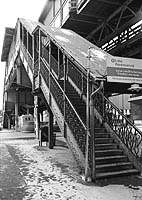
Northwest stairs to
the Clark/Lake elevated station, looking east in
1983. Note the decorative, original railings and
early KDR-style
sign and system map. For a larger view, click
here.
(Photo by Dan Clement,
from the Collection of the Library of
Congress)
|
In May 1985, the new $173 million State of Illinois Center
(SOIC) was completed and occupied. Only 17 stories tall
(with two additional levels below grade) but monumentally
designed by Helmut Jahn, the Center stands apart from
surrounding office buildings because of its dome-shape and
its multicolored glass exterior. With a low block design,
the glass-enclosed steel structure's curving, sloping facade
faces the corner of Randolph Street and Clark Street.
Likewise, the 203 N. LaSalle Building (aka the Loop
Transportation Building), across Lake Street from the State
of Illinois Center, was also completed in 1985. Later, the
Clark/Lake elevated station would be connected to these. But
not quite yet...
Clark had fallen into a serious state of disrepair when
renovations began in 1988 for the replacement of the old
elevated facility with a new, modern, white steel station, a
common design for new "L" stations referred to as the "open
plan concept." Beginning in January 1992, Clark/Lake was
closed weekends for the last of the reconstruction work,
which was largely completed a few months later.
The new station is actually located west of the old
station, between Clark and LaSalle. The new elevated
platform has a canopy that stretches the entire width of the
structure, with a convex skylight down the center. This
elaborate reconstruction was part of a new tri-level station
that connects the elevated with the ground-level street with
the O'Hare-Congress-Douglas subway station formally known as
Lake Transfer.
On March 23, 1992, the Clark/Lake elevated station's
entrances over Clark Street were closed and new access
opened from the newly-constructed elevated platforms to the
State of Illinois Center and 203 N. LaSalle Building. With
all access to both the Loop and subway stations through the
same access points -- also allowing transfers without
leaving a paid area -- the subway and elevated stations were
combined into a single facility known as Clark/Lake,
with the subway station thus dropping the Lake
Transfer moniker.
|
